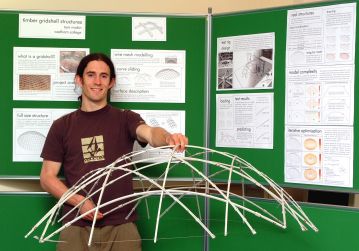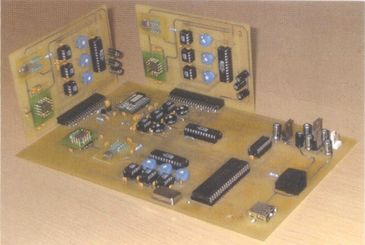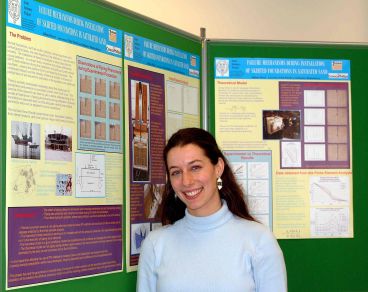| Issue 5 |
There was a lot more prize money to disburse this year, which not surprisingly resulted in a much larger entry. In earlier years the prizes had all come from the limited funds of the SOUE, but in 2005 Sharp Laboratories of Europe, through the good offices of Sunay Shah (Keble 1994-8) gave us £1000 (£500 of it for the best electronic exhibit), and they did the same this year. This inspired three SOUE Committee members, Philip Jenkinson, Claire Edwards and Douglas Craig, to see what they could do with their own firms. The result was £1000 from Atkins, £500 from GlaxoSmithKline and £400 from QinetiQ, which with the £1000 from Sharp and a modest contribution from SOUE came to £3100.
As a result of this, and improved publicity, we had 29 entries, and the exhibition overflowed from LR3 into LR2. The exhibits covered a wide range of activities, and in particular the offer of a £500 Atkins prize for the best civil or structural engineering exhibit elicited seven in that area, far more than we have ever had before, and Guy Houlsby arranged for them to be exhibited for an extended period in the Jenkin Building. Also we had our first ever EEM exhibit, which won the QinetiQ prize (see below).
There were 18 prizewinning exhibits, of which those that won the five larger prizes are shown in the photographs below.

|
Tom Makin (Wadham) won the £500 Atkins Prize for a civil/structural exhibit with "Timber gridshell structures". These slender doubly curved structures have good strength/weight properties, and the project was concerned with their design and analysis.

|
Jonathan Shipley (Lincoln) won the £500 Sharp Prize for an electronic exhibit with his "Low-cost inertial navigation system", containing three gyroscopes, three accelerometers and a three-axis magnetometer, all integrated into chips, and a microprocessor to do the "strap-down" calculations.

|
James Houston (New College) won the £300 QinetiQ Prize for an exhibit working towards an innovative solution of an important problem, with "International charter - space and major disasters". The "Charter" has been designed so that data observed from satellites may be readily obtainable for emergency use after floods, earthquakes etc. The project was to assess how well it was all working, and what could be done to improve it.

|
Christopher Shucksmith (BNC) won the £300 Hardware Section prize for "Airborne surveillance system". This was in fact a computer-controlled airship with several electrically-driven propellers to control its attitude and position, photographed in free flight here in the atrium of the IEB (Christopher in the left foreground).

|
Juliana Meyer (St John's) won the £300 Poster Section prize for "Installation of skirted foundations in sand", investigating some of the things that can go wrong with a new method for installing the tower foundations for offshore wind turbines. Water and sand are pumped out from inside the "skirt", which then sinks smoothly into the space left vacant. That at least is the intention!
12 other prizes of £100 were awarded as follows:
Simon Banfield, St John's, "Transverse horizontal-axis water turbine"
Jane Buckroyd, Jesus, "Tunnel-induced settlement damage to buildings"
Katherine Clough, St Edmund Hall, "Lexicographic text analysis"
Twinsen Cui, St Edmund Hall, "Blood flow modelling"
Jamie Darling, St John's, "Switched-mode power supply using transmission-line transformer"
Emma Rann, LMH, "On-line analysis of sulphur dioxide in wine"
Steven Raw, Worcester, "Electromagnetic detection of buried pipes"
Michael Reed, Queen's, "Design of airborne video surveillance platform"
Joseph Rigg, St Peter's and Alan Yee, St Edmund Hall, "Solar sheep" (two exhibits on a lawnmower robot)
Robert Skuriat, St Catherine's, "Power electronic cooling research"
Andrew Welling, Worcester, "Solute transport for inter-vertebral discs"
David Wong, BNC, "Formation of 'freak' waves on the open ocean"
Two of these that particularly intrigued the writer (who wasn't one of the judges!) were Simon Banfield's water turbine for extracting power from e.g. tidal currents in shallow estuaries, and Robert Skuriat's exhibit (much more fascinating than his title suggested!) showing how vapour bubbles in boiling coolant could be used to circulate this coolant at high speed around cleverly shaped channels.
The judges, who had to work very hard indeed to do justice to all these exhibits in the time available, were:
Douglas Craig, Balliol 1983-7, now with Qinetiq
Keith Crothers, LMH 1999-2003, now with Atkins
Claire Edwards, St Catherine's 1995-9, now with GlaxoSmithKline
Ben Hassell, Brasenose 1995-9, now with Cosworth
Jeremy Horne, Queen's 1992-6, now with BlueArc
We are very grateful to them, and to the sponsoring firms for their generosity.
| << Previous article | Contents | Next article >> |
| SOUE News Home |
Copyright © 2006 Society of Oxford University Engineers |
SOUE Home |